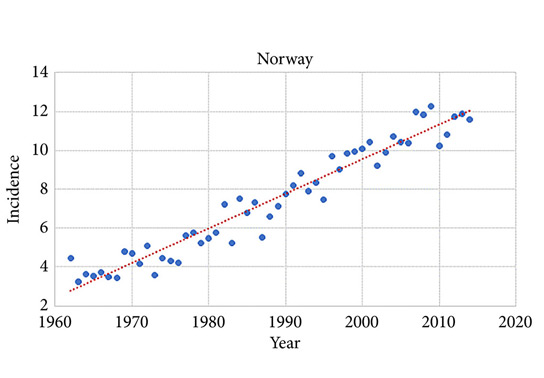Editorial: Occupational exposure and risk of testicular cancer: what can an ecological study in the Nordic countries tell us?
Examining the association between occupational exposure and incidence rates of testicular cancer over time in several countries may provide useful insights into the relative importance of lifestyle and environmental risk factors. The study by Ylonen et al. [1] assessed an ecological, rather than biological, effect of occupational exposure in order to understand differences in testicular cancer rates among populations; therefore, the authors could not draw causal inferences about the effect of occupational exposure on testicular cancer at the individual level [2]. Ecological studies are, however, a way of performing hypothesis‐generating population‐based research. They take advantage of the natural experiment following the changes in occupational exposure across countries [3].
Keeping the strengths and limitations of an ecological study design in mind, we should consider what can we learn from the study by Ylonen et al. [1]. Firstly, it is interesting to note that the authors themselves state in their discussion that ‘occupational exposure is probably not relevant’ for testicular cancer because the disease ‘is mainly diagnosed in young adults and the duration of occupational exposure before cancer diagnosis is short’. This highlights the fact that occupational exposure should probably be considered here as a proxy variable for other risk factors of testicular cancer: environmental exposure, physical activity, education, etc. This large study based on linkages of high‐quality data registers therefore merely aims to generate hypotheses. No clear patterns were observed, however, and future studies may benefit from similar ecological approaches using risk factors with a better rationale in the context of the aetiology of testicular cancer, such as socio‐economic statuts, diet or body mass index.
Secondly, the authors also note that this lack of unambiguous risk determinants and underlying mechanisms of testicular cancer makes it difficult to explain the geographic and temporal variations observed [1]. As the study did not have a hypothesis a priori, we find ourselves in a situation where occupational exposure may not be the best risk factor to examine in relation to risk of testicular cancer in an ecological study. The rationale for choosing occupational exposure as the risk factor is weak, and perhaps the authors would have been able to observe more clear patterns if they had conducted the study to assess bladder cancer, for which occupation has been a much more established risk factor and time to exposure has been found to be more relevant.
Thirdly, a clinical understanding of testicular cancer detection may inform changes in incidence over time and between countries. No additional information was provided by the authors, but changes in raising awareness of potential symptoms may have resulted in an increased incidence in a specific age group and/or country. Moreover, it would be of interest to know about differences among countries in terms of occupational exposure groups as this may also explain some of the patterns observed. A further assessment of the characteristics of different categories of occupational exposure could inform the patterns observed in this study and may shed light on the aetiology of testicular cancer.
In conclusion, ecological studies force us to think carefully about patterns of cancer incidence over time and among countries. Unfortunately, the findings cannot always lead to further hypotheses and careful consideration about potential risk factors needs to occur before conducting analyses. Moreover, detailed (clinical) knowledge is required about changes in diagnostic activity over time as well as potential changes in risk factor exposure. Future ecological studies using highly valuable resources, such as those used by Ylonen et al. [1] can help us understand cancer aetiology and prevention in more detail. They can be considered as a natural experiment to fill the gap in our understanding of the link between potential risk factors and risk of developing cancer.
London, London, UK
1 Ylonen O, Jyrkkio S, Pukkala E, Syvanen K, Bostrom P. Time trends and occupational variation in the incidence of testicular cancer in the Nordic countries. BJU Int 2018; 122: 384–93
2 Morgenstern H. Ecologic studies. In Rothman K, Greenland S eds, Modern Epidemiology, 2nd edn, Philadelphia, PA: Lippincott Williams &Wilkins, 1998: 511–31

